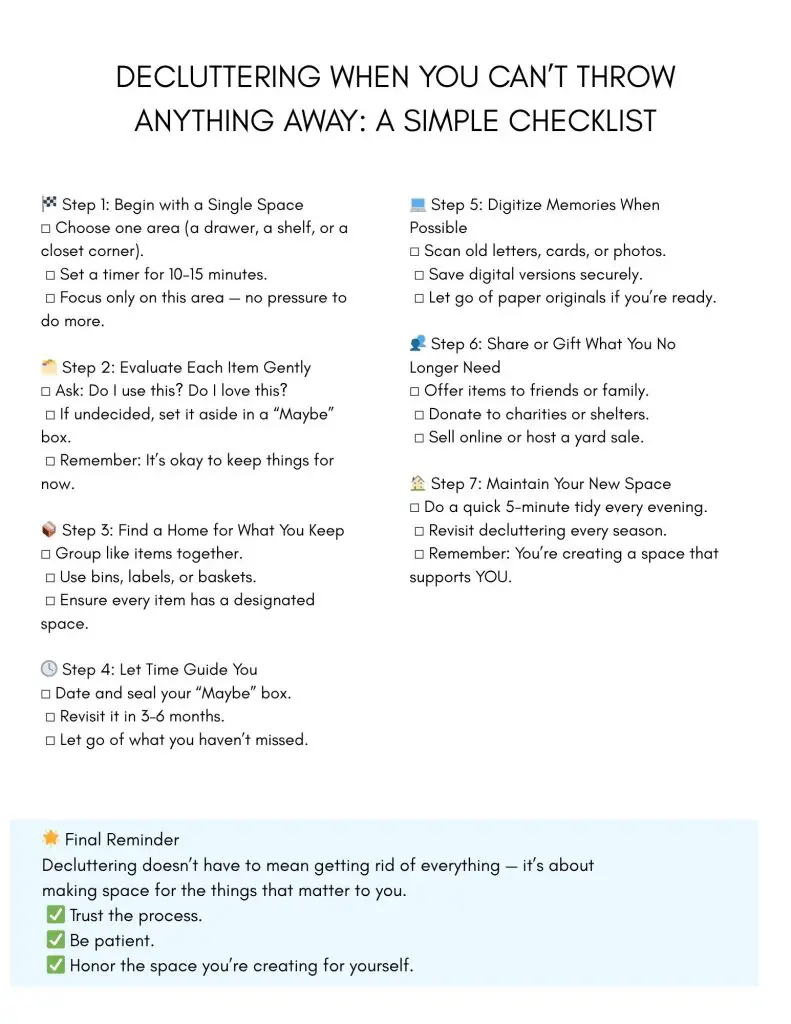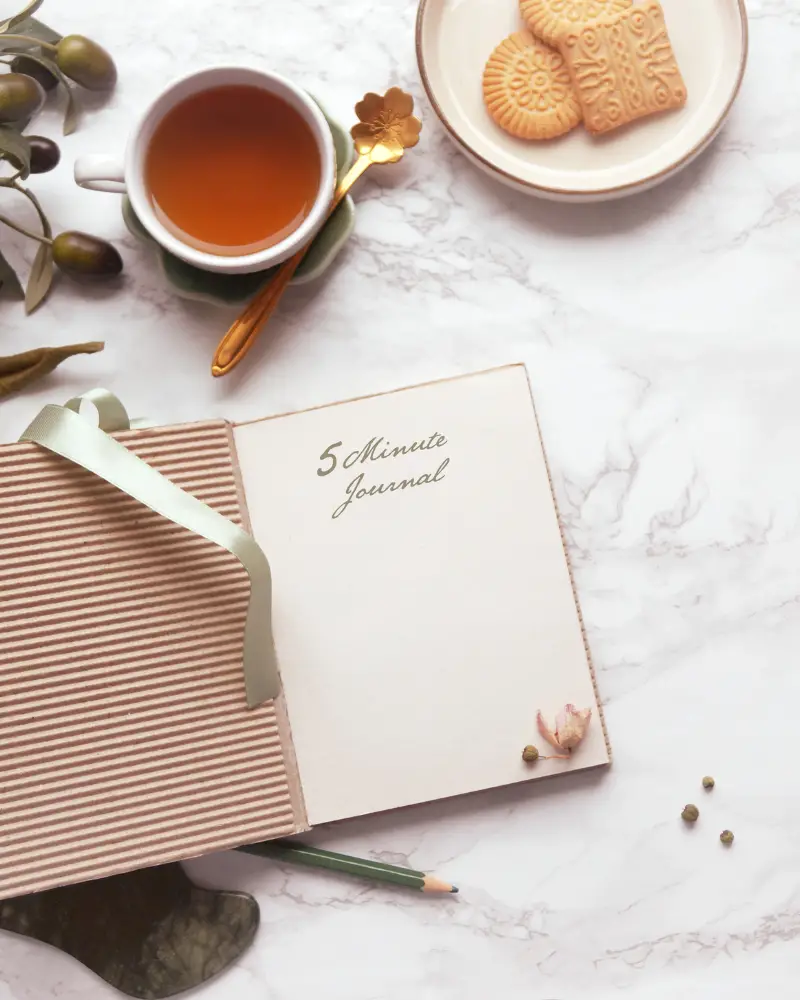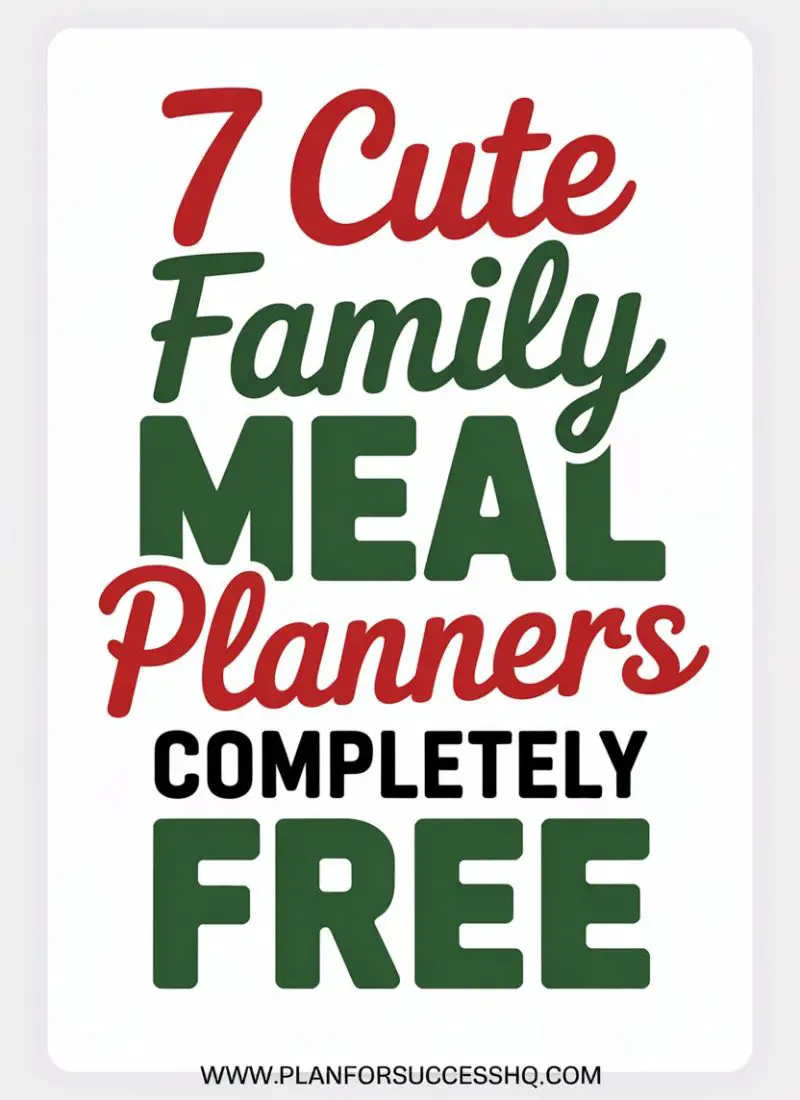Feeling overwhelmed by clutter — but can’t bring yourself to throw things out? You’re not alone. Whether it’s sentimental items, “just in case” stuff, or things tied to memories, letting go can feel impossible.
But here’s the truth: you can declutter your space without tossing everything in the trash. In this post, I’ll show you practical, no-guilt strategies for clearing space, reducing stress, and finding peace — without parting with what matters most.
This post may contain affiliate links, please read our disclosure policy to learn more.
Why It’s So Hard to Let Go
Decluttering is about more than just “getting rid of stuff” — it’s an emotional process that touches on memories, guilt, and even fear. For many of us, belongings aren’t just things; they’re tied to moments, milestones, and the people we love. Letting go can feel like saying goodbye to a piece of ourselves.
Maybe you worry about wasting money, or you fear that you’ll need the item later. Perhaps it was a gift from someone special, and keeping it feels like honoring them.
Whatever the reason, it’s okay to acknowledge that this is hard.
The first step to creating a space you love is accepting that your feelings are valid — and that you can declutter in a way that respects both your emotions and your home.
Accepting Where You Are
Decluttering doesn’t have to mean starting from a place of guilt or judgment. It’s about accepting where you are right now — surrounded by the things you’ve collected, cherished, or kept “just in case” — and knowing it’s okay. You’re not failing because your space is cluttered, and you’re not a bad person for holding on to things that matter to you.
Accepting your starting point means recognizing that every item has a story, and every story deserves to be honored — even if you eventually decide it doesn’t belong in your space anymore.
This is your chance to shift from a place of overwhelm to one of understanding, reminding yourself that every step forward counts.
It’s okay to go slow, to make decisions with intention, and to create a space that supports who you are now, not just who you used to be.
Redefine What Decluttering Means
Decluttering doesn’t have to mean throwing everything away. It’s about creating space — physically and mentally — for the things that truly matter to you. Sometimes it’s about curation, not elimination. It can mean finding a better way to store things, repurposing items, or even passing belongings on to someone who will love and use them.
Think of decluttering as making room for a calmer, more intentional space. It’s about gaining clarity, reducing overwhelm, and making sure every item in your home has a reason to be there — whether it’s for its beauty, its usefulness, or its sentiment.
Redefine it for yourself, and it becomes an act of empowerment, not loss.
Simple Strategies for Decluttering Without Tossing
Decluttering doesn’t have to be an “all or nothing” process. You can create a calmer, more organized space without feeling like you’re throwing pieces of your life away. Here are a few simple ways to get started:
- Try the “One Area, One Item” Rule: Focus on a single spot — a drawer, shelf, or closet — and pick one item at a time to review. This makes the process manageable and less overwhelming.
- Store Instead of Discard: Not ready to let go? Put cherished or “just in case” items into a clearly marked storage box and revisit it in a few months. Sometimes the space and distance make decisions easier later.
- Digitize Memories: Scan old letters, photographs, or documents so you can save the sentiment digitally and free up physical space.
- Gift or Share: Pass on items to friends, family, or charities where they can be used and loved. This way, your belongings can have a second life.
- Designate a “Memory Corner” or Box: Reserve a small, special space for the things that truly matter — making room for nostalgia without allowing it to overwhelm your space.
Decluttering doesn’t have to mean saying goodbye forever. It can be about making space for new moments, new memories, and a new sense of peace in your home.
Helping Others Understand
Decluttering can be challenging when the people around you don’t understand why you’re holding on to certain things — or why you’re struggling to let go. It’s worth remembering that everyone has a different comfort level with stuff, and that’s okay.
If friends or family push you to “just throw it all out,” calmly explain why certain items matter to you. Let them know that decluttering is about creating a space that feels right for you, and that doesn’t always mean getting rid of everything. Sometimes it’s about finding a better way to honor memories or organize belongings so they don’t overwhelm your space.
The key is focusing on open, respectful conversations — and reminding others (and yourself) that decluttering is a personal process, rooted in making your space work for your life, your needs, and your heart.
Making Peace with Your Space
At the end of the day, decluttering is about creating a space that feels like you — a space where memories and essentials can coexist, and where you don’t feel weighed down by guilt or “too much stuff.” It’s okay for your space to evolve slowly. It’s okay to keep certain things until you’re ready to part with them, and it’s okay to redefine what “decluttered” means for you.
What truly matters is making peace with your space and allowing it to support the person you are today. Let it be a place where you can rest, create, and find joy — surrounded by the things you consciously choose to keep. This is your space, your story, and your path to a calmer, happier home.
What Not To Do When You Can’t Throw Anything Away
Let’s be real — decluttering when you’re emotionally attached to your stuff is already hard enough. Don’t make it harder by falling into these common traps:
- ❌ Don’t start with the most sentimental items.
That old box of photos? Grandma’s teacups? Not your starting line. Begin with neutral, low-emotion areas like a junk drawer or linen closet. Build confidence before tackling the emotional stuff. - ❌ Don’t chase a Pinterest-perfect, minimalist look.
Your home doesn’t need to be a white-walled showroom. Decluttering is about clarity and comfort, not empty surfaces. Keep what you love — just make sure it has a home. - ❌ Don’t declutter on someone else’s timeline.
Friends, family, or social media influencers might say “just get rid of it all!” — but they’re not you. Take your time. This is your space, your pace. - ❌ Don’t let guilt call the shots.
If you’re keeping something only because you feel bad getting rid of it, ask yourself: Does this item serve me today? Your peace matters more than a gift you didn’t choose. - ❌ Don’t ignore your own needs.
If the clutter is making you anxious or stuck, that’s your cue. You don’t have to part with everything, but you do deserve a space that supports your well-being.
🌟 Final Thought: You’re in Control of Your Space
Decluttering when you can’t throw anything away is challenging, but it’s worth doing — one step, one area, one item at a time. Remember, it’s not about achieving perfection or meeting someone else’s standards. It’s about creating a space that supports you, tells your story, and feels like a true reflection of the life you’re living right now.
👉 If you’re ready to take that first step, grab our FREE Decluttering Checklist! It’s packed with simple prompts, tips, and ideas to help you declutter with compassion and intention.
Save this post to Pinterest, or share it with a friend who needs a gentle reminder that making space can be an act of self‑care. You’ve got this — and your space will thank you. 💗





Leave a Reply